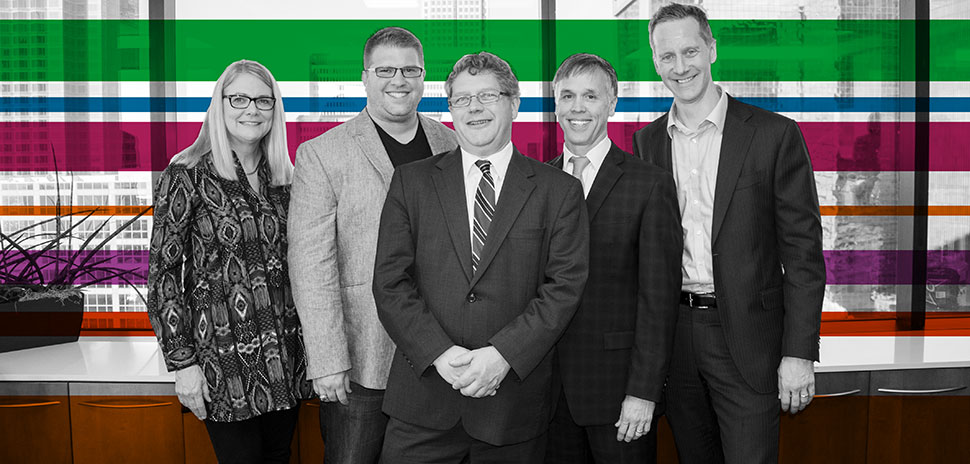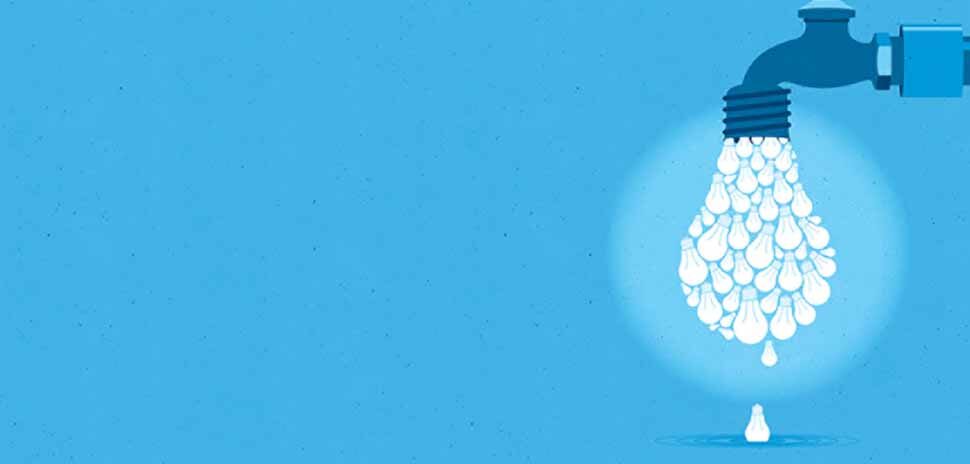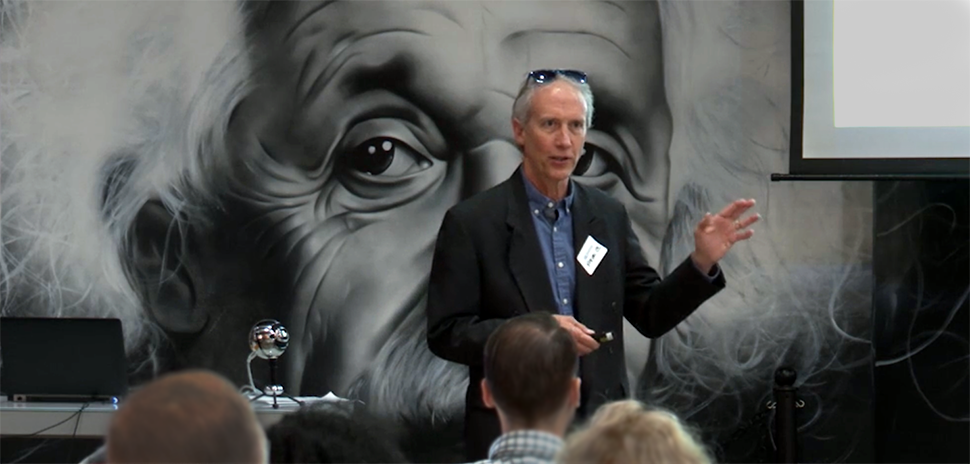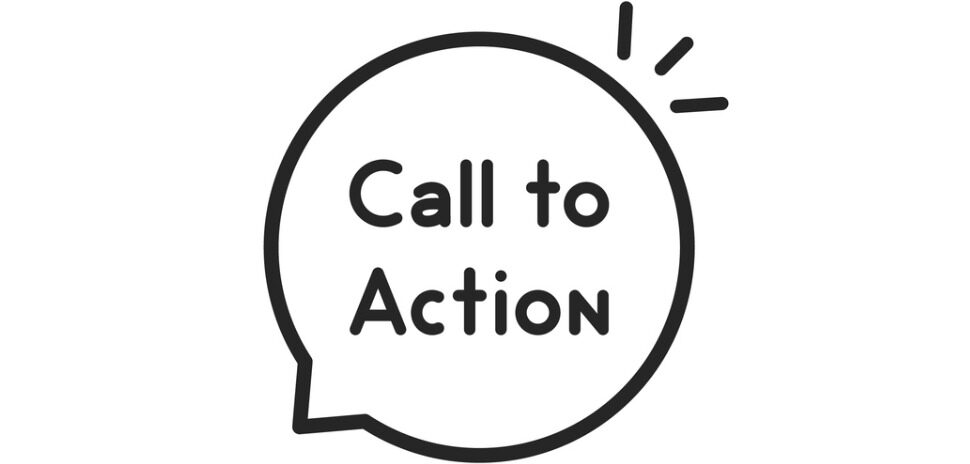Economist Bart Van Ark led a conversation about the future of innovation with Fortune 1000 leaders from Microsoft, IBM, Sabre, and Blue Cross Blue Shield at the Signposts of Innovation panel discussion Oct. 3 at the Dallas Regional Chamber offices in Dallas. Panelist talked about ways that companies can create a culture of creativity. Van Ark is in charge of strategy development and new initiatives at The Conference Board, and heads a team of more than 20 economists in New York, Brussels, and Beijing. Here is the final part of our series on the panel’s discussion.
Signposts of Innovation panelists were Cindy O’Shea of IBM, Mark McSpadden from Sabre, Bart van Ark of The Conference Board, Lane Sorgen of Microsoft, and Dr. Paul Hain of Blue Cross Blue Shield.
Artificial intelligence
Bart van Ark: Mark, let’s pick the top question because it has been liked by two people. That’s very important these days. Likes are very important. So, machines join the workforce. What innovation strategies are you putting in place to hone the fears about AI in the workforce.
Mark McSpadden: AI in the workplace…OK. This is interesting because now my team checks in every morning via bots, but we don’t do a daily standup is that whenever you check in, in our slack room, I have a bot that then says I’m glad you’re here today and what are you working on?
That’s more for our team to know, but what’s each other working on?
So, I’m embracing the AI future as opposed to calming the fears around it. I kind of don’t know where we want to go with that.
Bart van Ark: Anybody else on the panel?
Cindy O’Shea: From a IBM perspective, it’s augmented intelligence. AI has been around for a while and that’s cool how you do yours.
AI, it’s been around a long time, so I’m not embracing it. I don’t subscribe to it taking over the world. Really, what’s important about it, certainly in health care, the volumes in data, the ability for a physician to keep up with what’s happening in their field, and it’s very difficult. So, if we’re able to provide an adviser to help determine and take those electronic medical records and really understand what’s going on with a patient and comparing that to other patients to determine what type of care would be expected to be the best outcome.
So, we really embrace it. We feel it’s cognitive business as a part of the next era of computing.
Dr. Paul Hain: We’re certainly using it at our customer call service centers. We have some AI running in the background. As you know, not every human being is as in tune with other human beings’ feelings as we might like them to be, so we have a program running in the background that says to the person taking the call, the caller is getting agitated or the caller is responding positively to what you’re saying.
So, using both tone and voice and word selection, we have an algorithm running in the background helping our call center folks to understand what’s going on in the mind of the caller, so we find it very helpful.
Bart van Ark: I’ll take one more question and then we’ll take one more poll question. Let’s take the top one because four people think we need to deal with the question. How do you take into account the unique needs of innovators to get their best work out of them?
Mark McSpadden: I think a big part of this that we’ve seen is a move towards, especially for our makers, a synchronous communication. So, we check in via chat room every morning and that’s because I have people on my team that get up really early and if I do a 9 a.m. standup, that’s right in the middle of their flow. That is terrible for a programmer working on something to say hey, I know that you just flowed all this context into your brain and you just now figured out how to address this problem, but stop for a second and listen to what I had for breakfast. I think a move to a synchronous communication has helped us quite a bit in giving people the autonomy they need to be able to keep moving.
Cindy O’Shea: I would add to it, in terms of unique leads of our innovators is having the agile collaborative space and white boards that are actually black boards, have stickies. You have to take ranks and go play table tennis—that’s popular right now.
Of course, the variety of hours…they do their best work, I think, from 10 p.m. to the wee hours of the morning.
Mark McSpadden: Hacker hours, 10-2.
Dr. Paul Hain: Right. I also think that we could take out our basics of human behavior.
That face to face serendipity can be lost in today’s corporate maneuvering. I know back when I was on faculty at the medical institution, we tried hard to have a lot of chance encounters with each other. What’s going on in your lighthouse? How are you doing?
You never know what you don’t know. And when somebody says that they’re working on something, often, things you’ve never agreed were possible suddenly become possible because you didn’t know something was about to be meant in the lab next to yours.
I think the same thing can be very beneficial inside corporations.
Lane Sorgen: I think, first of all, we really were born with a culture of allowing people to approach business the way they want. I started in the product groups and people with purple hair and flip flops and all of that is very common. People working nights opposed to days was very common. We had basketball courts everywhere.
Really, the company culture is such that this in itself, that’s who we are. The problem, though, with innovation is in our company, when we had 10,000 people, you could do that and people would go do their work and everything worked, but when you get up in front of 150,000 people—you know, I printed over 90 million dollars in software sales this year…software and service sales.
When you start thinking about that and the fact that literally, every bit of this is supposed to work together, then you start having a real glitch. How do you communicate across these different groups?
So, the short of it is, over the past five years, we really put a lot of effort into culture. So, four years ago, we revised our compensation system and there are three tenants that are used in defining your compensation. One-third of it is actually helping others and sharing others and we put metrics, so every year, we get better and better at understanding how well people are helping others. Really, that’s sent people to work inside their time frame, but also, to help others.
Culture + Soft measures of innovation
Bart van Ark: You actually are bringing us to the next view on the second poll question I wanted to ask, and that is about culture, and more broadly, about soft measures of innovation. So, let’s move a little back. But, we’ve heard a lot, as I mentioned earlier, regarding if they are saying, well, we have some of those metrics, but we need these culture things that we’re missing.
So, here again is the question. It’s open for both right now. You can only select one. What is the most important measure of soft innovation that you’re missing?
AUDIENCE POLL
What is the most important measure of soft innovation that you’re missing?
(Audience voting)
Flash audience poll results
32 percent are talking about assessing leadership and peer behaviors to encourage innovation and learning as the most important one missing.
20 percent are saying measuring the degree of strategically rewarding innovation among key departments.
15 percent are saying metrics capturing value of failure.
Bart van Ark: Let’s start with the panel.
Lane Sorgen: I’ll start since I started the discussion. I’ll just call out one thing that is a detail in our measurement systems that are in soft measures. We find it really hard to assess individuals and how much they were contributing to other boards. You can put a lot of fluff in it. So, how do you make this also not super objective?
So, after one year into a reward system where a third of my compensation is set based on how well I work with others and help others, we actually implemented the view that says, what have you actually used of other people?
The reality is that with Microsoft, the biggest issue we have in helping other people is we’ve had so much emphasis on people—the whole notion that if it wasn’t created here, it’s not a good idea—great things can be created and we weren’t sharing things, so we didn’t have an issue at all inside Microsoft innovation.
The problem was everybody innovated the same thing and we had 15 versions of speech recognition, one for each of the different products, and that, again, goes back to the time.
Anyway, there is a very clear metric we were filling out and doing four times a year where we are actually asked as leaders to document and explain what we’re doing in terms of sharing best practices or learning from other groups.
The byproduct, interestingly, is we’ve got a whole lot more people that are interested in me helping them once they have to actually look at that.
So, as one of the leaders, I can see that it’s making a returnable difference. I hope we get to the measuring of impact later, but it’s a good start.
Mark McSpadden: One of the things that we’ve done with metrics capturing the value of failure…it’s a competitive thing, but we have posted the events that are all about gutter. If you haven’t had an internal event about ways that you failed, I think you’re missing an opportunity to share stories about you’ve tried and haven’t worked.
One of the guys has been there 15 years in our labs group, so the best thing to hear people be able to say is, you know, we tried this once and it didn’t work. We think it was because this, this, and this. I wonder what it would be like to try it now or I wonder if that has changed.
So, being able to bring that attitude to the failure, I think, is also real interesting. So, go make an internal failure meeting and ask for submissions. See how it goes.
Cindy O’Shea: That’s a good one. I’ve been saying we are missing the soft measures, in particular about culture and in particular about new tools that we’re using to collaborate. I don’t know if we are just—you know, everybody is using Get Hub and Slack and everything else, but we haven’t been able to measure yet how it has improved productivity or collaboration or innovation.
Bart van Ark: … We think of innovation in startups. But, what about small enterprises with, say, less than 30 employees. What advice would you give to just regular small companies?
Mark McSpadden: Well, I would say you use one of these companies as an entry point to leverage yourself. We deal a lot with startups, not necessarily that I can help you, but I can connect you with any organization to help you achieve the thing you want to achieve, so you can let a big company handle the piece they do really well, and you can innovate on the space that’s really unique to the piece that you’ve taken. So, utilize groups like ours.
Cindy O’Shea: That’s a great point. I would add that there’s a lot of resources out there from an IBM perspective. In fact, you can run Watson on the IBM cloud on a 30-day free trial. What a great opportunity to get a first-hand experience.
In addition to that, for small startups, there’s a set of APIs out there called Glumix. You can also interact with Watson in natural language. There’s a lot of functionality. So, go out there. The trials are free. There’s also a lot of partner programs that will be joint, where IBM will help invest, and certainly, if you have a creative idea.
Dr. Paul Hain: The idea that we have these, kind of, incubators in ways to get the large corporations to help you, I think, is incredibly useful. The one piece of advice I would give is that I’ve seen a whole lot of startups asking to talk to Blue Cross, and 90% of them show up with an idea. It’s not a product and not anything you can post. But, I had this idea that it would be really cool to do this. I’m like, great.
So, if you can make it long enough to actually have something that is a little closer to product, that’s super helpful.
Lane Sorgen: And I’ll close with, sort of, a point around that. The first thing I would tell them is while I’ve explained some of the things I think we’re doing much better at Microsoft in terms of innovation, again, I started with how we’re better now than we were…there’s still far to go to be truly breakthrough innovative thinking.
The smaller companies, I think, you don’t have a lot of baggage and history there, so the opportunity is huge. The cloud and the devices and network availability…there’s almost no startups. So frankly, I think you’ve got the best recipe for actually innovating.
What I would close with is I think one of the reasons that the four of us were brought here is we all have innovation sites that are for us and for our customers, and that’s where I think people really want to lean on.
Anybody ever been to Chili’s and you see the little device on the table? You play games, pay all your bills, and all that. That actually came from an SMU research paper that somebody picked up and said, hey, can you come help us?
In about a week’s time, he put it together and proved the concept, and it just so happened that we knew a few people that might like to buy it.
So, I just think there’s great resources in these four companies and others, and thank you for letting us have a chance to share.
Delivering what’s new and next in Dallas-Fort Worth innovation, every day. Get the Dallas Innovates e-newsletter.

































